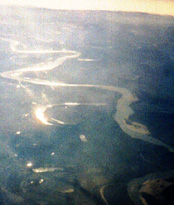
Living Downstream:
An Ecologist Looks at Cancer and the Environment
Sandra Steingraber, Ph.D.
(Reading, Mass.:Addison-Wesley, 1997)
Afternoon sun reflected off of the Mississippi River.
Overview
“Since the development of the Ames test and other biological tests to measuring the mutagenic potency of chemicals, it has become increasingly evident that we live in an environment full of mutagens." # 3.
Gordon Edlin, a genetics authority: Human Genetics, (Boston: Jones & Bartlett Publishers, 1990).
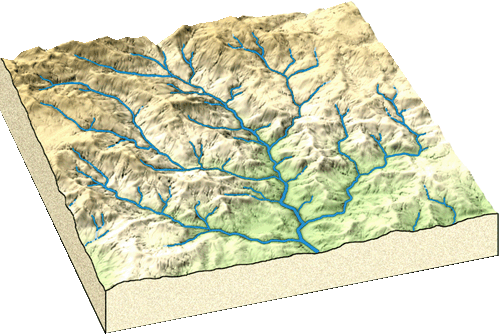

Rivers are a three dimensional metaphors standing for our sensitivity to exposure and our sensibility concerning functionally necessary and constituent parts of places.
Nature is a gift common to all precisely because it is an artifact that created us and is sustained by all of its constituents .
√ What we don't know can kill us
• What we don't see is more important or as important as what we do see
• How we use our knowledge is a measure of our effectiveness
Any life is the weaving of a texture among people and their values with places, wildlife and fisheries so that in telling a story we unravel the threads binding us to the elemental wonders that dwell in the mystery at the core of all living things.
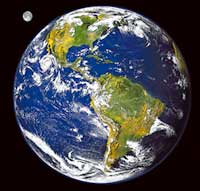 Themes
Themes
loss is inevitable and recovery is a blessing
ignorance is a form of collective loss; loss of will, loss of memory and loss of the desire to inform one another.
knowledge belongs to everyone but is invested with good returns among the curious
human rights to health are inalienable, even if we trade away the foundations on which healthy lives depend
a meaningful life must in some sense be a testimony to the places and people we adore
"we have squandered our resistance for a pocket full of promises"
running scared
making connections among the unseen and the –as yet– unconnected reveals a startling pattern of an unraveling world where ecological and human health are quite tightly entwined in an embrace as beneficial as it is lethal.
Return to the start of the page
 |
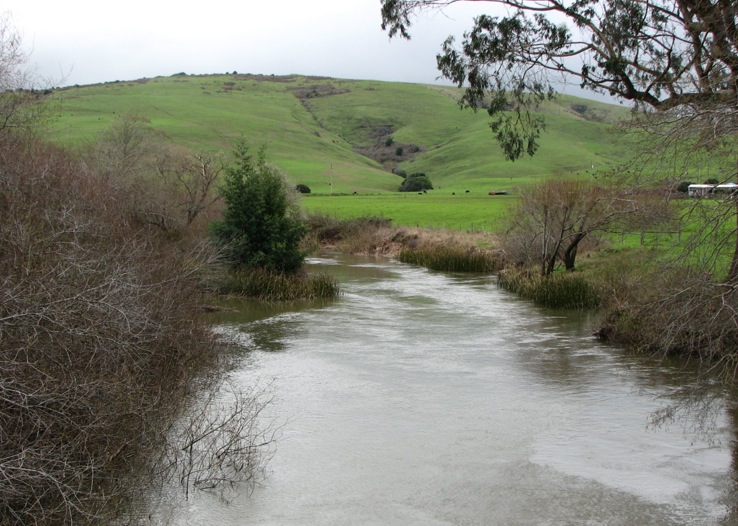 |
| Contents | |
|
|
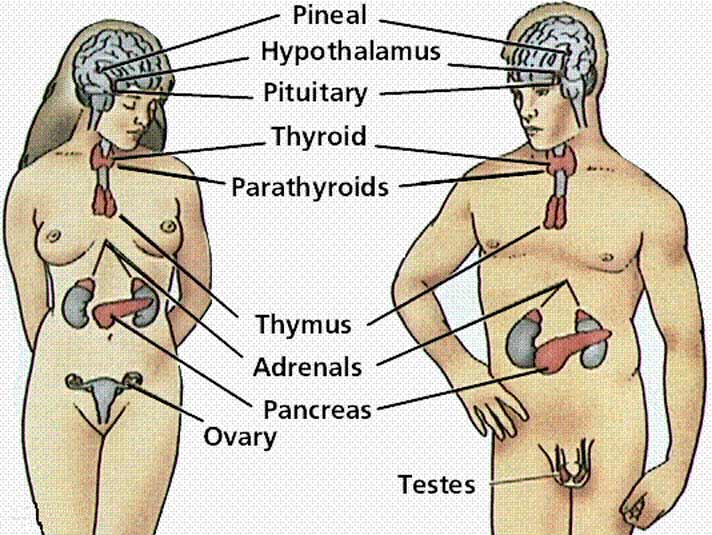 |
|
Return to the start of the page
xiii
“prairie. Its a romantic sentiment. Almost none of us who live here has ever seen prairie--”
“the aspect of the landscape that spawns tornadoes.”
xv
“a direct link has been found between tobacco smoke and
lung cancer.”
“a single component of cigarette smoke --benzo(a)pyrene--causes genetic
mutations in lung cells.”
“These mutations occur not only in the exact same gene -- called p53--but
in the exact same location”
xvi
“those who had the courage to act on partial evidence.”
“however imperfect our scientific tools: with the right to know comes the duty to inquire.”
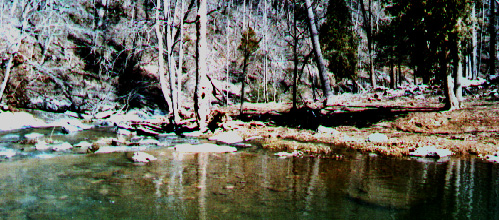
“a fable about a village along a river”
“This book is a walk up that river.”
Return to the start of the page
On Page 3:
“Illinois soil holds darker secrets as well. To the 89
percent of Illinois that is farmland, an estimated 54 million pounds of synthetic
pesticides are applied each year.
1-3
"In 1993, 99 percent (corn fields) were chemically treated”
“In 1993, 91 percent of Illinois rivers and streams showed pesticide contamination.”
1/4 of all the private wells in central Illinois “contained agricultural
chemicals”
Some of the pesticides inscribed into the Illinois landscape promote cancer
in laboratory animals. Some, including one of the most commonly used pesticides,
atrazine, are suspected of causing breast and ovarian cancer in humans. Other
probable carcinogens, such as DDT and chlordane, were banned for use years ago,
but like the islands in a preglacial river valleys, their presence endures.”
Breast cancer and DDE
7
“the harmless aspect of the familiar.” She quotes Rachel Carson
DDT --------> metabolizes into DDE; high levels of DDE in women with breast
cancer.
PCBs and Lindane levels are high in women with breast cancer.
11
definitive study of women in NYC (1993), 14,290 samples
Blood of “breast cancer patients contained 35 percent more DDE than that
of healthy women.”
“women with the highest DDE levels are four times more likely to have breast
cancer.”
Eric Dewailly study in Quebec,
“when Dewailly restricted his comparison to estrogen-receptor positive tumors (that is, tumors sensitive to the presence of estrogen), the difference became more striking: DDE levels were substantially higher in women with estrogen receptor positive cancers than in women of the control group. (Pp. 11-12)
13
“women born in the U.S. between 1947 and 1958 ...have almost three times the rates of breast cancer than their great grandmothers did when they were the same age.”
return to the start of the page
2 silence
2-20
Breast cancer robs women of 20 years of their life expectancy in the US
15
Review of Silent Spring and Rachel Carson’s private papers
18-19
her friend Jeanni Marshall and her rare spinal cancer.
Both Sandra and she (Jeanni) became cancer patients in their twenties!
24
Rachel Carson and Breast Cancer
29
on the role of evidence and sufficiency of the data
“Like the assembling of a prehistoric animal’s skeleton, this careful
piecing together of evidence can never furnish final or absolute answers. There
will always be a few missing parts, first because experimenting on human beings
is not, thankfully, considered ethically acceptable. Human carcinogens must,
therefore be identified through inference.”
“Another reason for scientific uncertainty is that the widespread introduction of suspected chemical carcinogens into the human environment is itself a kind of uncontrolled experiment. There remains no unexposed control population to whom cancer rates of exposed people can be compared.”
more on the character of science and causality
return to the start of the page
"Time is like a river made up of the events which happen, and its current is strong; no sooner does anything appear than it is swept away, and another comes in its place, and will be swept away too."
Marcus Aurelius, [Meditations IV, p. 43]
"and time enough"
"Time is but a stream I go fishing in."
Henry David Thoreau (1817-1862)
A wanderer is man from his birth.
He was born in a ship
On the breast of the river of Time.
Matthew Arnold [1822-1888]
"a cancer diagnosis is an authoritative pronouncement, one with the power to change your identity."
"Most of the traits and skills you bring with you from your native life are irrelevant."
on 32-33:
Gene frequency and cancer evidence as changes in the population occur
41
“One fourth of all cancer deaths are from lung cancer.”
“Overall, approximately 87 percent of deaths from lung
cancer can be attributed to cigarette smoking.”
43
“the environment, it seems, keeps falling off the cancer
screen.
45
“The failure to evaluate systematically the relationship
between rising cancer rates and rising exposures to environmental carcinogens
is beginning to receive attention.”
Devra Davis, cancer research
study was based on the year people were born and the year the c was diagnosed
“Davis found that cancer not tied to smoking has increased steadily down the generations. US White women born in the 1940s have had 30 percent more non smoking cancers than did women of their grandmother’s generation (women born between 1888 and 1897). Among men the differences are even starker. White men born in the 1940s have had more than twice as much non-tobacco-related cancer than their grandfathers dis at the same age.”
Davis says “is that there is something going on here in addition to smoking,
and we need to find out what that is.”
50
Non-Hodgkin’s lymphoma incidence
51
“Non-Hodgkin’s lymphoma has shot up-- approximately tripling in incidence since 1950.”
52
“Evidence for an association between phenoxy herbicides and Non-Hodgkin’s lymphoma (NHL) comes from several corners.”
Midwest farmers, Swedish studies show sixfold > incidence due to exposure
& NCI.
56
fuel rod assembly released radioactive wastes from the Pilgrim Nuclear facility in Plymouth on Mass. Bay (Cape Cod Bay) there is a cluster of incidences of higher than average leukemia cases from five near-by towns. The causes remain unaccounted for.
return to the start of the page
4 space
58
“The distribution of cancer across space, like the trajectory through time, reveals clues about its possible causes.”
“Paradoxically the closer we stare at the map of cancer, the more unclear
the picture becomes.”
58-59
“Recall that cancer rates are based on the number of people annually diagnosed for each 100,000 people. Determining whether a cancer cluster exists in a small community of only a few thousand or a few hundred inhabitants is statistically difficult work, and it is at this level where the fiercest arguments fly.”
“Industrialized nations have disproportionately more cancers than countries
with little or no industry (after adjusting for age and population size.).
“One half of all the world’s cancers occur among people living in
industrialized countries, even though we are only one-fifth (20%) of the world’s
population.”
“Breast cancer rates are thirty times higher in the US than in parts of
Africa, for example.”
Five times higher in the US than in Japan.
“Especially alarming is the rapid rise of brain cancer mortality among
those over sixty five years old-- a pattern mirrored throughout the industrialized
world.”
"Death from cancer is not randomly distributed in the United States. Shades of red consistently light up the northeast coast, the great Lakes area, and the Mouth of the Mississippi River. For all cancers combined, these are areas of the highest mortality; they are also the areas of the most intense industrial activity."
63
"Counties with the higher levels of contamination may also have worse health care: cancer patients from more polluted, more pesticide-saturated counties may be dying at faster rates simply because they are receiving poorer treatment."
63-64
return to the start of the page
5 war
Her father fought in the Italian theatre in the Second World War
"technologies developed for wartime purposes had changed chemistry and physics forever."
88
The terms organic and synthetic are slippery ones and require explanation.
90
organochloride compounds
"They are not a legacy from the industrial revolution of the 19th century, but of the rise of the chemical industry of the 20th."
David Ozonoff, MD, epidemiologist.
115
return to the start of the page
Petri dishes of cancer cells
"Alive they look to me like bats."
118
endosulfan (widely used on salad crops) is estrogenic
"Like the hormones it mimics, endosulfan stimulates breast cancer cells to divide and multiply."
like raindrops, analogy
119
return to the start of the page
"Rachel Carson once remarked how strange it was to live in an age when carcinogens were a basic element of our system of food production."
"...outright solutions exist all around us.
In Iowa,... a group of soybean farmers completely replaced a carcinogenic herbicide with tillage systems and planting techniques that use shade to control weeds."
169
Jim Bender, completely chemical free corn and soybean operation
170
"... he and Emily have never eaten tofu....Standing in a rented field that's full of them, I try, at the top of my lungs, to describe the taste of soybeans."
172
return to the start of the page
"The thing about air in Illinois is that there is so much of it. Air is a more conspicuous element here than in any other place I've lived. It seems deeper, wider, more present."
173
nitrogen dioxide
"Closing a lethal circle, air pollutants have also been implicated in promoting the spread of cancer from other organs to the lung. For example, melanoma afflicted mice that breathed air polluted with nitrogen dioxide developed more tumors in their lungs than those that breathed clean air."
First, nitrogen dioxide impedes so-called killer T cells, whose function, among others is to rid the body of wandering tumor cells."
Second, nitrogen dioxide causes blisters to form deep in the lung's airy chambers, where such errant cells can then become trapped."
184
"Thus like its chemical offspring, ozone, nitrogen dioxide raises thorny questions about causality. Nitrogen dioxide is not as far as we know, a carcinogen (cancer triggering risk). And yet, for those of us who have had cancer, its presence in the air may affect our chances of surviving our disease."
184-854
return to the start of the page
On the west bank of the Illinois (River), the floodplain spreads out like a dance floor in a pool hall. Its mostly corn and bean fields now--all the way up to the power plant and the coal piles..."
185
"Suddenly, we are in thick woods that draw a curtain on the river's floodplain behind us.
In conclusion, it is difficult to interpret the epidemiological evidence on ambient air pollution and lung cancer."
186
"Old descriptions of the Illinois wilderness, including the valley I am now driving through, provide detailed observations of its air--how sweet or rank were its odors, how salubrious or potentially pestilent its breezes.
Whether the excess risk of lung cancer can be attributed to urban air pollution cannot be determined conclusively, but it is suggested that it at least contributes to the risk."
In fact, the national incidence of asthma has jumped 40 percent in the last decade and is now the number one cause of absenteeism for American school children."
187
"Increases in childhood asthma and the clustering of lung cancers around cities with dirty air are telling us something."
sufficiency of evidence and thorough scientific understanding should not cause us to pause, idle or sit quietly for the results: comparison is made to cholera and fecal contamination of the water supply. Sometimes, often you need to act on partial information and err on the side of caution.
188
more on the character of science and causality
return to the start of the page
"in getting to know this river I was raised beside, I've relied as much on library research as on my own observations. These sometimes tell two different stories."
"stand on the river's edge beside what looks to be an immense pile of stone butterflies."
189
"These men are, in fact, mussel gatherers showing off their catch."
Surface and groundwater contamination
"As a general rule, contamination of lowland areas of discharge --where aquifers give up their water to rivers and streams-- is considered a lesser problem than contamination in the upland areas of recharge where aquifers receive rain and snow from the atmosphere. Areas of recharge are the headwaters of aquifers, and contamination here can fan out and fill the whole."
208
City of Pekin, Illinois passed a groundwater ordinance in 1995 creating a 2000 foot ring of protection around each well-head.
"..hailed as a model for the state."
209
"Of course, ecologically speaking, everyone drinks from aquifers: all running surface water was at one time groundwater, aquifers being the mothers of rivers."
"Groundwater provides no archival photographs to consult. It offers no shores to walk along, no reflective surfaces to peer into, no fish, no bivalves, grasses or game birds to inquire about. Our relationship to aquifers is deeply biological, but it is not visual."
210
"Cultivating an ability to imagine these vast basins beneath us is an imperative need. What is required is a kind of mental divining rod that would connect this subterranean world to the images we see every day: a kettle boiling on a stove, a sprinkler bowing over the garden, a bathtub filling up.
Our drinking water should not contain the fear of cancer."
The presence of carcinogens in groundwater, no matter how faint, means we have paid too high a price for accepting the unimaginative way things are."
211
return to the start of the page
"Were following the river valley south into mason County on ... Manito Blacktop."
"The houses along the blacktop have a scattered, haphazard feel to them--as though the river gave permission to strew one's possessions about. Propane tanks, extra cars, satellite dishes are parked in sloping yards alongside signs advertising the sale of garden produce. The soil here is very porous, a fact made evident by the irrigation center pivots that lie over the fields like skeletons of enormous bats. These draw water up from the Sankoty Aquifer and spray it in all directions. They grow a lot of specialty crops here --green beans, peas, sweet corn, cucumbers, pumpkins and melons-- as well as standard issue field corn and soybeans."
213
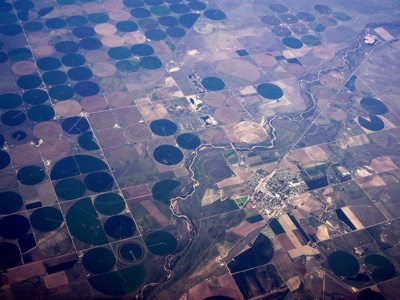
Garbage incineration (waste to energy facilities 1 to 15 > in Illinois, after 1994) surface and groundwater contamination.
"The first problem flows from a primary law of physics....matter can neither be created nor destroyed." (much of the gas is carbon dioxide)
216
On January 11, 1996 the Illinois General Assembly repealed the retail rate law. According to the governor, "Most communities do not want the incinerators. And it is time we stopped asking our taxpayers to subsidize them."
1/25/1996 John Kirby died of malignant mesothelioma--a form of lung cancer--in a Springfield, Illinois, hospice.
234
"Among the forest trees, size and age can be remarkably dissociated. Seedlings germinating in deep shade are often swiftly overtaken by those sprouting up in light filled spaces nearby, Saplings browsed by a passing deer lose vertical height relative to their neighbors less palatable. By these and other means, senior members of a forest community sometimes grow old beneath a canopy of younger trees."
235
"That's how I remember it, too. Everybody lost their vocabulary."
return to the start of the page
"Something about the landscape changes abruptly between northern and central Illinois. I am not sure what it is exactly, but it happens right around the little towns of Wilmington and Dwight. The horizon recedes and the sky becomes larger. Distances increase, as though all objects are moving slowly away from each other. Lines become more sharply drawn....It is only early evening, but the fields are already dark, a patchwork of lights quilted over and across them. They have always soothed me, I look for signs of snow. There are none"
"Several obstacles, I believe, prevent us from addressing cancer's environmental roots. An obsession with genes and heredity is one."
"No one can quantify what the loss of a creek means to a child in Tennessee or measure the grief of parents who must forbid their son or daughter from exploring along its banks."
369
Boston,
Reflections on a health article about the effects of a mixture of low level doses of substances, including dioxin from an Illinois landfill on the hormones of young female rats.
371
"Dust. Soil. Air. The year after my cancer diagnosis, I signed up for a field ecology class and learned to identify plant species in the rarest of rare Illinois habitats: the black soil prairie. Its remnants are almost completely confined to a few old pioneer gravesites. Hunkered down between the headstones, I cupped the unfamiliar plants in my hands and tried to will into existence thousands of acres of these grasses and herbs, the sound of animals running, wildfires, birdsong.
I look at the brown, spiny flowers and then out the window at the city I live in. Dust. Soil. Air. What I see are the contours of home.
372
###
Summary
 Places are the product of what genes have caused them to become
under the relentless working of natural rules.
Places are the product of what genes have caused them to become
under the relentless working of natural rules.
The rules are: things never go away, everything is tied up together with anything; something always lingers although nothing ever wholly survives without some form of transformation over time.
Also, places are laden with traces of occupation, steeped in the chemicals left over from acquiring security, and filled with the tragedy of a widespread unwillingness to confront the dread at the heart of our civilization: environmental contamination is not only condoned, but a healthy ecology is not, as yet, part of people's inalienable human rights.
The burden of proof remains with the victims and falls not the perpetrators, manufacturers, engineers, research technicians, or sales executives whose products cause the harm.
Pollution is seen as the cost of doing business.

Topos is the Greek term for place the singular example of places.
Places are the ecological repositories of past practices (time and space):
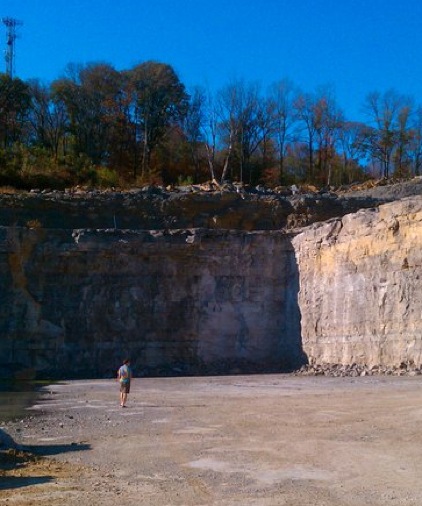
Our sense of place then is circumscribed the the location of the poisons within the older idyllic frame of households, homes, homesteads and homing instincts.
Oikos, human household.
Oikumene, neighboring households in relation to transformed landscapes.
discourse | rights| Research links | Reliable places to search
Williams | Jackson | Siry | Austin | Hundley | Carr | Margulis
Overview | Themes | Contents | Summary | Compounds | nitrogen | food | a River | What health is | Focus
Science Index | Site Analysis | Population Index | Global Warming Index | Nature Index | Brief